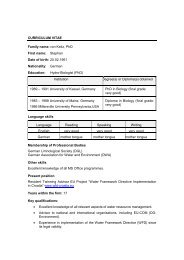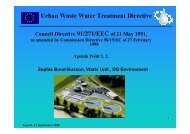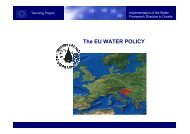BIODIVERSITY OF CROATIA
BIODIVERSITY OF CROATIA
BIODIVERSITY OF CROATIA
Create successful ePaper yourself
Turn your PDF publications into a flip-book with our unique Google optimized e-Paper software.
UNVEGETAT<br />
B. INLAND UNVEGETATED AND SPARSELY VEGETATED HABITATS<br />
The most interesting habitats of this class are the screes, cliffs<br />
and exposed limestone rocks. A number of endemic and relic<br />
plants and plant communities are represented, distributed mostly<br />
on the mountains and coastal areas.<br />
Screes develop where stones, rock fragments and pebbles<br />
accumulate at the bottom of slopes. Specially adapted plants<br />
grow here, the most significant among them is the endemic<br />
species Velebit degenia (Degenia velebitica) of the specific<br />
community of Bunio-Iberetum pruitii which has developed on<br />
Velebit mountain screes exposed to stormy winds.<br />
Cliffs and exposed limestone rocks are inhabited with rockcrevice<br />
vegetation that often contains endemic taxa. These communities<br />
belong to the Tyrrheno-Adriatic or Alpine-Carpathian-<br />
Balcanic group of habitat types. One of the most important<br />
communities is Phagnalo-Centaureetum ragusinae with the<br />
Croatian endemic Dubrovnik knapweed (Centaurea ragusina).<br />
Karst area of Bijele Stijene (White Rocks) is protected as the strict<br />
reserve (photo: SINP)<br />
A detail form the Bijele Stijene strict reserve (photo: SINP)<br />
Konavoske Stijene (Konavle Rocks) in Southern Dalmatia are rich with<br />
endemic plants (photo: SINP)<br />
A scree on the Biokovo mountain (photo: A. Alegro)<br />
27









